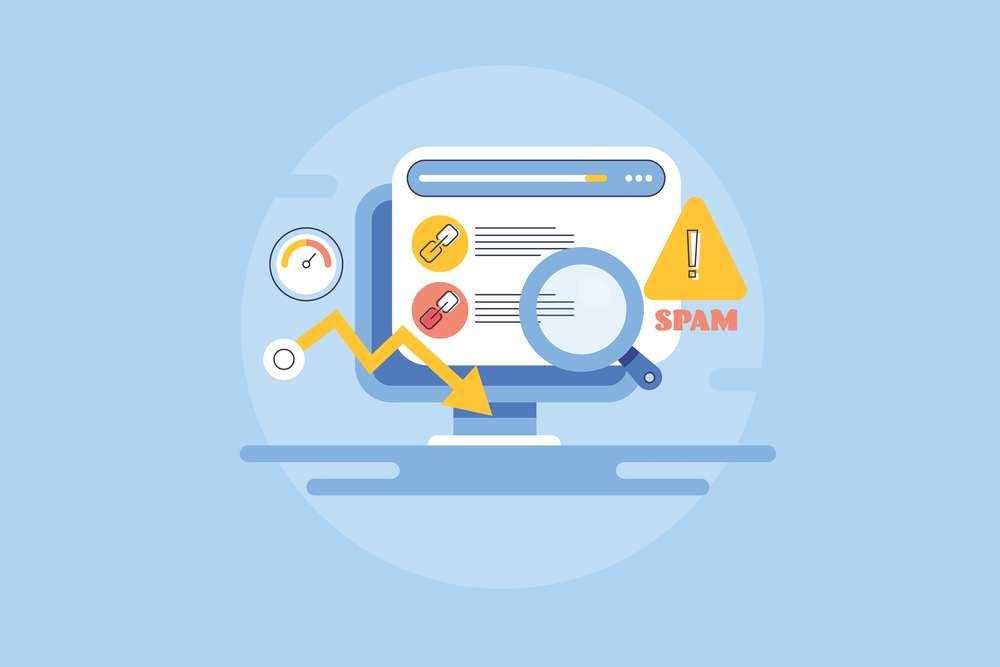Negative SEO is a term used to describe the practice of intentionally harming a competitor’s website rankings. This can be done through various unethical techniques. It involves deploying malicious tactics that violate search engine guidelines. The sole purpose is to damage the targeted website’s online visibility and reputation.
People might do negative SEO for different reasons, like wanting to win in a mean way or to hurt others. Competitors or mean people might use it to harm their competition, steal visitors, or make a site look bad.
There are different types of negative SEO techniques that attackers can employ. A trick attackers use is messing up a site’s backlinks to look bad. They add lots of bad links or buy irrelevant ones to hurt the site’s reputation. Negative SEO Affects Your Website in many ways.
Another form of negative SEO revolves around sabotaging a website’s content quality and relevance. Bad people might copy a site’s content on different sites. Which causes problems with repeated content and search engines giving penalties. In this article will explore how negative SEO affects your Website.
Negative SEO can also target the user experience (UX) of a website. Bad people might do things like fake clicking ads on a site to waste money. They might also slow down or break a site. Good design by Sarasota uses smart SEO to protect against these and keep a site’s reputation.
3 Types of Negative SEO Techniques
Negative SEO attacks can take different forms, targeting various aspects of a website’s optimization. Knowing these tricks helps find and reduce harm from these attacks.
Link-Based Negative SEO
Link-Based Negative SEO means being mean to a site’s links to make it look bad. Bad people make bad links on purpose to trick search engines. They want the site to seem bad or like it’s cheating with links.
Attackers may employ various tactics to execute link-based negative SEO. One common technique is to generate a large number of irrelevant or low-quality backlinks and direct them to the targeted website. These backlinks may come from suspicious or spammy sources. Which includes link farms, directories with no editorial control, or private blog networks (PBNs).
Another trick is buying links from bad or unrelated sites to connect to the target. This makes lots of links, but they’re not good. Attackers want search engines to punish the site and make it rank lower.
Content-Based Negative SEO
Content-Based Negative SEO is a bad thing that messes up a site’s rank and name by hurting its content. Bad people use tricks to make a site seem bad or not real. One way is copying a site’s stuff and putting it on different sites, which makes the same thing appear in many places.
The presence of duplicate content can negatively impact a website’s search engine rankings. Search engines strive to provide users with the most relevant and unique content. When they detect duplicate content, they may penalize the website by pushing its rankings down in the search results. This can have a significant impact on the website’s organic traffic and overall performance.
Another content-based negative SEO tactic involves manipulating on-page content elements. Attackers may alter the targeted website’s meta tags, titles, headings, or keyword density. Which mislead search engine algorithms. By doing so, they aim to diminish the website’s relevance and authority in the eyes of search engines.
User Experience-Based Negative SEO
User Experience-Based Negative SEO focuses on sabotaging the user experience (UX) of a website. Bad people who do this type of negative SEO use tricks to make a site bad for users. They want to hurt the site’s name, make it rank lower on searches, and get people to leave.
One common tactic used in user experience-based negative SEO is click fraud. Attackers generate artificial clicks on a website’s advertisements. This leads to an increase in invalid or fraudulent clicks. This malicious activity can exhaust the website’s advertising budget. Which results in wasted resources and a diminished return on investment. The presence of excessive invalid clicks can also raise concerns for advertising platforms. It can potentially lead to the suspension of advertising accounts.
Another bad thing attackers do is mess up a site’s speed and make it stop working. They use DDoS (distributed denial of service) attacks to send too much traffic, making the site slow or not work. This makes visitors mad and leaves, which means the site loses customers and sales.
1. The Impact of Negative SEO on Your Website

The impact of negative SEO on your website can be significant and detrimental to its overall performance and online presence. Negative SEO tricks mess up search engine rules, making your site’s rank go down. This makes it hard for people to find your site, which means fewer people visit.
For a website to do well, getting organic visitors is important. These are the right people who might like your stuff or buy something. With a loss of organic traffic due to negative SEO, your website’s visibility and reach are severely hampered. This decline in traffic can result in a decrease in leads, conversions, and revenue.
Moreover, negative SEO attacks can tarnish your online reputation. Attackers might use tactics like making bad reviews, spreading lies, or posting bad things about your brand. This makes people not trust you and harms your name, losing customers.
Another consequence of negative SEO is the potential for search engine penalties. Search engines always change to give users the best experience with good stuff. If bad people do negative SEO like bad links or repeated content, search engines might punish your site. This can make your site rank lower or disappear from search results.
2. Detecting Negative SEO Attacks
Finding bad attacks is important for site owners to keep their online name and reputation safe. By being proactive and vigilant, you can identify and respond to these attacks in a timely manner. Here are some effective strategies to detect negative SEO attacks:
One of the key indicators of a negative SEO attack is a sudden and significant drop in your website’s search engine rankings. Keep a close eye on your rankings, especially for your top keywords. If you notice a sudden decline without any apparent reason, it could be a sign of a negative SEO attack.
Monitoring your backlink profile is another important aspect of detecting negative SEO. Regularly review the backlinks pointing to your website and analyze their quality and relevance. Look out for any suspicious or toxic backlinks that have been recently added. Tools like Google Search Console and third-party SEO tools can help you monitor and analyze your backlink profile.
Referral traffic can also provide valuable insights into negative SEO attacks. Monitor your website’s referral traffic to identify any unusual patterns or spikes from irrelevant or spammy sources. Pay attention to traffic sources that seem suspicious or generate low-quality traffic to your website.
Duplicate content is another tactic used in negative SEO attacks. Conduct regular checks to identify instances of duplicated content on other websites. Tools like Copyscape can help you detect plagiarism and identify websites that have copied your content. If you find duplicate content that originated from your website, take immediate action to rectify the issue. You can also report it to search engines.
Monitoring your website’s performance metrics is essential in detecting negative SEO attacks. Keep an eye on metrics such as page load speed, bounce rate, and overall site health. Sudden drops or unusual fluctuations in these metrics could indicate the presence of a negative SEO attack. It happens especially if they coincide with other suspicious activities.
3. Protecting Your Website from Negative SEO
It is impossible to completely eliminate the risk of negative SEO. Still, there are proactive measures you can take to safeguard your website and minimize its vulnerability to such attacks.
Strengthening Website Security
Strengthening the security of your website is crucial in protecting it from potential negative SEO attacks. As bad online stuff gets smarter, it’s important to make your site safe and protect its important information.
One of the first steps in enhancing website security is to ensure that all software and plugins are regularly updated. People who make websites often give fixes and updates to stop problems and keep sites safe. By keeping your website’s software up to date, you can minimize the risk of attackers exploiting known security loopholes.
Also, use strong and special passwords for all your site’s important accounts. Simple ones can be guessed by machines. To be safer, use long and tricky passwords with letters, numbers, and symbols.
Regularly Monitoring Website Analytics
It’s important to often check how your site is doing with analytics. Tools show info about your site’s performance, what people do on it, and where they come from. This helps you decide how to make your site better and reach your goals online.
One of the key benefits of monitoring website analytics is the ability to track and understand the traffic coming to your website. You can know where your visitors come from search engines, directly, other sites, or social media. This helps know which ways work best, so you can spend time and effort smartly.
How Negative SEO Affects Your Website

Recovering from a negative SEO attack can be a challenging and time-consuming process. You can fix problems and make your site better with smart plans and steps. This can help your site’s rank and name.
One crucial step in the recovery process is to document evidence of the negative SEO attack. Collect proof like pictures, reports, or times that show bad tricks on your site. These will be important when talking to search engines or getting help.
Once you have collected the necessary evidence, it’s important to disavow any harmful backlinks that point to your website. Google’s Disavow Tool lets you ask to ignore certain links. This helps when search engines look at your site’s importance and relevance. This step helps prevent the negative impact of toxic or unnatural backlinks on your website’s rankings.
Besides ignoring bad backlinks, make your site better overall. Do this by creating good content that people want. This makes search engines trust your site again and brings in visitors.
Conclusion
Negative SEO is a menacing threat that can undermine the hard work and success of website owners and digital marketers. Knowing about bad SEO and how it hurts your site, and learning ways to stop it, keeps your site safe. Watch your site often, and use safety steps. This protects your site from bad things and makes it strong. Good website design like Sarasota’s helps protect from bad SEO by being safe and strong. We explain many factors that negative SEO affects your website.
